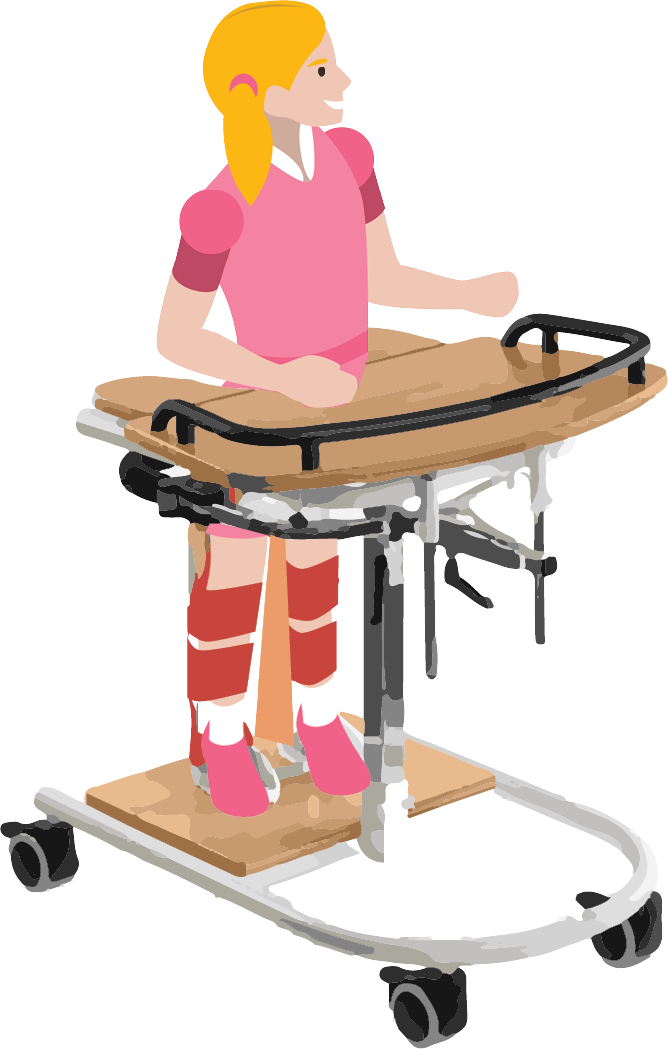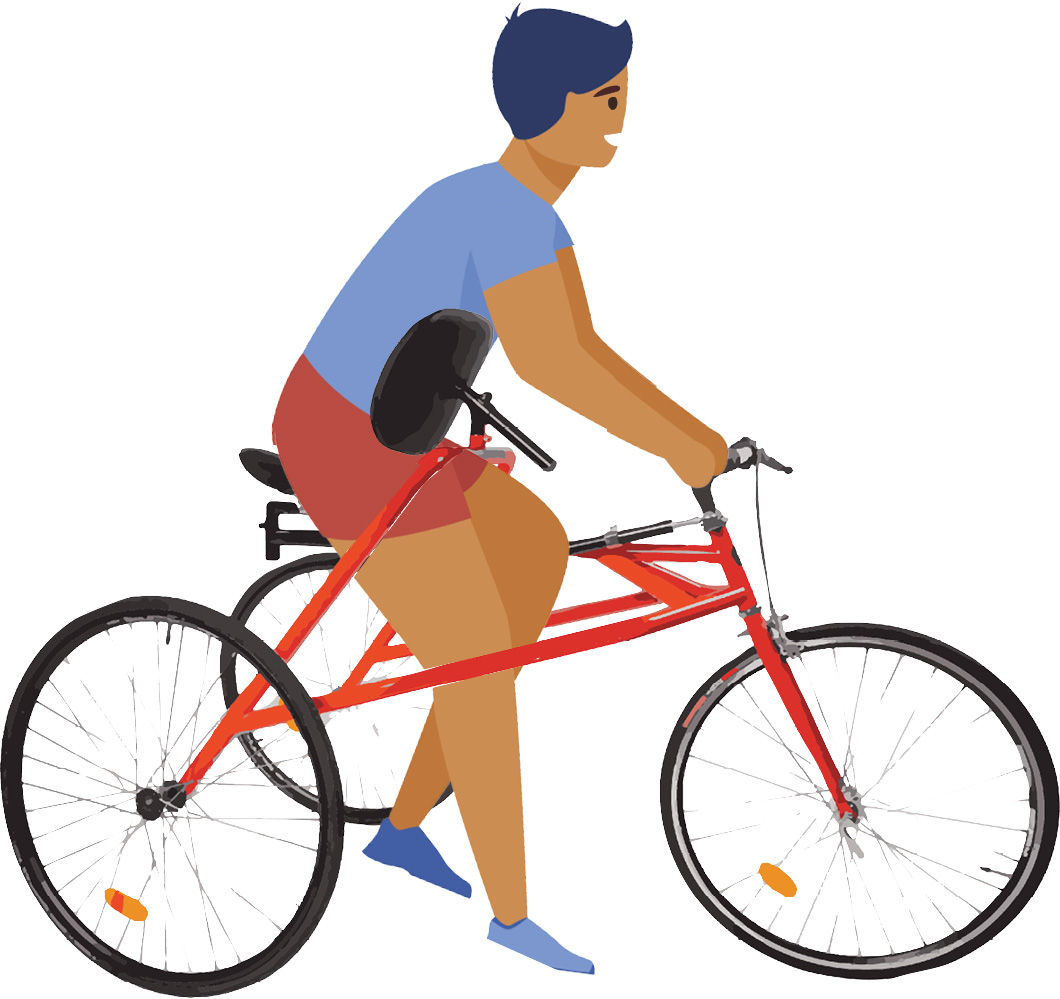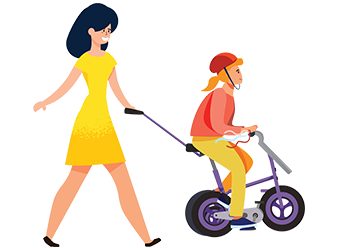Equipment to support standing activities
Standing frames

For persons with limited mobility and who primarily rely on a wheelchair, a standing frame will enable the person to engage and participate in standing activities.
Types of standing frames include
- Supine stander: If the person has difficulties with head and trunk control a supine stander is often suitable.
- Prone stander: If the person can somehow assist with the transfer and has some head control a prone stander could be appropriate.
- Active/dynamic stander: This type of stander offers motor-assisted and repetitive movement of the arms and legs while standing. If arm movement is desired specialized straps/gloves will help the hands to hold on to the handles.
- Sit to stand: This is a combination of a chair and stander. Using hydraulic or electric power the person will be assisted in the transfer from sitting to standing. In the standing position the stander will provide the necessary support.
Tips
- Work together with your therapist to assess what the individual needs
- Consider the person’s level of head and trunk control and gross motor skills
- Consider whether the person needs a standing frame with specific modifications to accommodate joint contractures or scoliosis
- Consider the type of activities that person will engage in while standing to choose the most appropriate type of standing frame
- A trial period is recommended before you buy or apply for a standing frame
Equipment to support mobility activities
Walkers

For persons who walk with assistance from a carer (one hand/two hand support, trunk support) a walker could be suitable to enable more physical activities. At the same time the carer will ‘have hands free’ to support the person’s participation in different activities. Often as the person gets older, he/she gets heavier and may experience more difficulties with muscle strength and balance skills which puts more strain on the carer. In that case a walker might be an option to consider
Types of walkers include
- Anterior/posterior rollators: This is for persons with the ability to use their hands to hold on and push/pull the rollator forward. Rollators are for those who do not need much support to help them with their balance.
- Forearm walkers: This is for persons who need more weight and balance support but have some ability to use their hands to hold on and push the walker forward.
- Anterior walkers: These provide anterior support and are suitable for persons who need some trunk support.
- Posterior walkers: These provide posterior support and are often suitable for persons who need more trunk and pelvis support.
- Walkers with seat/saddle: For persons with reduced endurance and muscle strength you may consider a walker with a seat to allow the person to take small breaks during the walking activity. You can use a walker with a seat or saddle without needing to hold on with your hands.
- Walking slings: This is for persons with good leg strength to stand upright, but who experience poor balance. To be used indoors in rooms with ceiling hoists and may be found in classrooms and activity centres.
Treadmill
A treadmill is another walking option. Parents and therapists have observed that this kind of walking activity is great fun and very motivating for some persons with Rett syndrome. One of the benefits of treadmill walking is the rhythm and flow that comes with the continuous walking cadence. It can be used with a walking sling if the person needs support for weightbearing and balance. Consider treadmills with a wide base and a slow walking cadence when it’s turned on.
Racerunner

A racerunner is a running/walking frame which allows the person to experience speed and freedom of movement while supported. Frame running is actually a sport for people with disabilities. The racerunner can also be used as a leisure activity together with family and friends when they go for a run or bicycle trip.
Tips
- Work together with your therapist to assess what the individual needs
- Consider the person’s level of trunk control, gross motor skills and hand function
- Some of the walking equipment has handles but does not necessarily require hands to move forward
- If hand holding is required, consider using a glove or Velcro strap
- Consider the type of activities that person will engage in while walking and whether the activities are indoors or outdoors to choose the most appropriate type of walking equipment
- A trial period is recommended before you buy or apply for walking equipment
- You may need to try out different walking equipment to find the most suitable one
Equipment to support cycling activities
Adaptive tricycles

Cycling offers another type of physical activity and lets the person experience the outdoors in new ways. Many persons with Rett syndrome seem to enjoy the fast movements of the legs and feeling the wind on their face. Some persons may be able to propel the pedals by themselves while others may need to be assisted in a companion cycle.
Types of adaptive tricycles include
- Two wheels at the back: This makes the tricycle easier to turn and maneuver through sharp curves. Require hands to hold on to handlebars.
- Two wheels at the front: This makes the tricycle easier to wheel and provides a sense of the width of the bike. Require hands to hold on to handlebars.
- Side-by-side: This allows the person to cycle together with a companion/assistant. If the person experiences reduced leg muscle strength and endurance this would be a good option.
- Some tricycles will have an attachment for a caregiver to help with steering.
Tips
- Consider the person’s needs of support. It is possible to customize the adaptive tricycles with different saddles, trunk support, back rest and pedals.
- If hand holding is required, consider using a glove or Velcro strap
- A trial period is recommended before you buy or apply for adaptive tricycles
- It’s often necessary to try out different adaptive tricycles or additional positioning equipment to find the most suitable one
Other equipment to support activities
Adapted equipment

Due to limited hand function in many persons with Rett syndrome you can consider adapted and switch-operated equipment to enhance participation in ‘uptime’ activities in home, school and community settings. Below you will find a few examples.
- Switches: Many types of switches exist in different shapes, sizes and textures. Most switches require that the person press the button with the hand and/or fingers. Some even react to very slight touch or a by squeezing the switch. Observe the typical hand movements of the person and try out a couple of different options.
- Switch-operated toys and equipment
- Musical instruments to play while standing
- Bowling ramp to use while standing or walking
- Water gun to use while standing and playing with friends
Here are some example of switch operated activities:
- Games with dice or bingo where the person can be the ‘caller’
- Adaptor for electronic devices e.g. connect to kitchen appliances for standing kitchen activities

